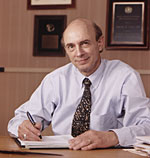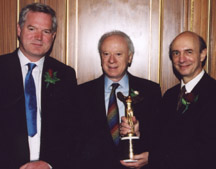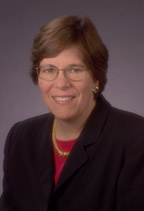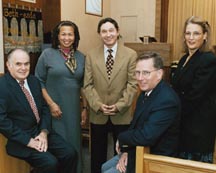 |
Dr.
Harvey Alter, chief of the infectious diseases section and associate
director of research in the CC Department of Transfusion Medicine,
received a Lasker Award for clinical medical research in September
ceremonies.
|
Prestigious Lasker
Award for 2000 honors Alter
The Clinical Center's
Dr. Harvey J. Alter received the 2000 Lasker Award for clinical medical
research during ceremonies in New York City on Sept. 22.
He shares the award
with Dr. Michael Houghton, a scientist with the Chiron Corporation.
The Lasker Award honors Dr. Alter's ongoing studies to uncover the causes
and reduce the risks of transfusion-associated hepatitis and Dr. Houghton's
continuing work in molecular biology to isolate the hepatitis C virus.
"Dr. Alter's
studies of hepatitis have tremendously benefited the nation's public
health efforts in the arena of blood safety," said Dr. Ruth Kirschstein,
NIH principal deputy director. "His work spans 35 years of creativity,
focus and tenacity."
"What makes
the Lasker Award so special is the scientific stature and eminence of
the people who nominated and elected me to be the recipient," commented
Dr. Alter on his selection. "That such individuals would recognize
my work as important and clinically significant is by far the highest
honor I could achieve. "Clinical research seems motivated by three
major elements: the desire to understand the causes and mechanisms of
disease, the wish to do something that will have genuine relevance to
patient care, and the hope that the science will merit the respect of
other scientists. The first two elements are to some extent under the
scientist's control, but the latter is ephemeral and perhaps the hardest
to achieve.
"Just as a
study has limited relevance until it is peer reviewed, so too does a
scientific life. The Lasker Award is validation at a level that I never
anticipated, and I cherish it. It is peer review that fortunately requires
no corrections or resubmissions. My level of gratitude is significant
at a P-value that approaches infinity."
"He is a model
for the clinical scientist," said Dr. John I. Gallin, CC director.
"He has been a leader in the effort to improve blood safety, and
his investigations have been instrumental in the virtual elimination
of transfusion-associated hepatitis in the United States."
A native of New
York City, Dr. Alter earned his MD degree at University of Rochester.
He came to the NIH Clinical Center as a senior investigator in 1969.
He currently is chief of the infectious diseases section and associate
director of research in the Department of Transfusion Medicine.
"As a young
research fellow, Dr. Alter co-discovered the Australia antigen, a key
to detecting hepatitis B virus," noted Dr. Harvey Klein, chief
of the CC Transfusion Medicine Department. "For many investigators
that would be the highlight of a career. For Dr. Alter it was only an
auspicious beginning."
 |
| With
Dr. Alter (right) following the awards ceremony are Dr. Michael
Houghton of the Chiron Corporation, and Dr. Joseph Goldstein, chairman
of the Department of Molecular Genetics and the University of Texas
Southwestern Medical Center, who headed the Lasker Awards selection
jury. In his remarks during the ceremony, Dr. Goldstein noted, "The
Clinical Award honors a scientist from a company, Chiron Corporation,
and a scientist from a federal research institute, the NIH, for
their discovery of the hepatitis C virus and its elimination from
the blood supply. This award illustrates the increasing importance
of collaboration between the biotechnology industry and the traditional
research enterprise. This is the first time that a Lasker prize
has recognized the biotechnology industry. |
Thirty years ago,
about a third of transfused people received tainted blood, which later
inflamed their livers, producing a condition known as hepatitis. To
combat this problem, Dr. Alter spearheaded a project at the Clinical
Center that created a storehouse of blood samples used to uncover the
causes and reduce the risk of transfusion-associated hepatitis. Because
of his work, the U.S. instituted blood and donor screening programs
that have served to increase the safety of the blood supply.
Dr. Alter used this
repository of clinically linked blood samples to identify another puzzling
clinical problem. "Most transfusion-related hepatitis was found
to be due to a virus different from the two then-known hepatitis agents,
A and B," Dr. Alter said. He called this new form of hepatitis
non-A, non-B hepatitis and subsequently proved through transmission
studies in chimpanzees that it was due to a new agent.
Vigorous efforts
in dozens of laboratories failed to identify the presumptive virus or
develop a test for it. Eventually, a Chiron Corporation team led by
Dr. Houghton exploited the blossoming methods of molecular biology to
isolate the virus now known as the hepatitis C virus. The Lasker Awards,
first presented in 1946 and often called America's Nobels, annually
honor the country's most outstanding contributions in basic and clinical
medical research. The Lasker Awards are administered by the Albert and
Mary Lasker Foundation; the late Mary Lasker is widely recognized for
her singular contribution to the growth of NIH and her commitment to
the cause of biomedical research.
On the web:
http://www.laskerfoundation.org/
>Joint
Commission visit set, preparations in final countdown
We're in the final
countdown for the Nov. 1-3 accreditation survey conducted by the Joint
Commission on Accreditation of Healthcare Organizations. "Clinical
Center staff have done a tremendous job preparing for this year's survey,"
noted Dr. David Henderson, CC deputy director for clinical care. "Since
the Joint Commission conducts its survey visits every three years, we
are always in a cycle of review and re-evaluation to make sure that
we meet the set standards. Now is the time to bring it all together."
This year's survey
team will move away from formal presentations in meeting rooms and onto
patient-care floors. "The team will be on the floors, observing
patient care, checking for safe and sanitary conditions for workers
and patients, and other activities," added Dr. Michele Evans, the
CC's safety officer. Laura Lee, special assistant to the deputy director
for clinical care, described a possible scenario: "Because of the
JCAHO's more interactive approach this survey cycle, the team could
identify a nurse or a doctor to follow into a patient's room, observe
the care being given, and then ask questions about why something was
done. They also may ask questions about what patient education was done,
confirm that with the patient, and then check to be sure that care provided
to the patient is documented in the patient's medical record. Despite
ever increasing patient-care demands, the staff on the units and in
the departments are doing an amazing job of getting ready for the survey--every
single person deserves huge kudos."
Results from a mock survey last April has helped focus final preparations
and included some encouraging observations:
- The physical appearance
of the hospital is significantly improved
- Staff are terrificÑinterested
in learning, eager to share information, empowered to interact with
the surveyors.
- The planning process
is integrated at the leadership/department level.
- Performance improvement
is integrated at the leadership/strategic planning level.
New
nursing chief named
 A
former CC head nurse in ambulatory care and director of nursing marketing
is the new director of nursing. Dr. Clare Hastings returns to the CC
from the Washington Hospital Center to become chief of nursing and patient-care
services on Oct. 9. A
former CC head nurse in ambulatory care and director of nursing marketing
is the new director of nursing. Dr. Clare Hastings returns to the CC
from the Washington Hospital Center to become chief of nursing and patient-care
services on Oct. 9.
Dr.
Hastings will manage a staff of about 600 nurses, clerks, and support
personnel who provide patient care and research support on 33 inpatient
and outpatient units. She is responsible for overseeing and developing
nursing practice across the institution, and for aligning nursing department
goals and activities with the strategic plan and priorities of the Clinical
Center. She will also work with institute and CC leadership and clinicians
to see that intramural research programs are well supported.
"It's an exciting
and challenging role," said Dr. Hastings. "I'm impressed with
the Clinical Center's revitalization efforts. I'm looking forward to
rejoining former colleagues and meeting new people." She will play
an integral role in the move to the Clinical Research Center in 2003.
"That will involve looking at clinical care and figuring out how
to reorganize and redesign operations to fit into a different space,"
she said. "It will mean creating larger combined units that are
more multipurpose. It presents many challenges both administratively
and operationally."
Dr. Hastings earned
a PhD in nursing from the University of Maryland in 1995, an MS in nursing
administration from Georgetown in 1985, a BSN from the University of
Maryland in 1977, and a BA in anthropology from Reed College in 1971.
At Washington Hospital Center, Dr. Hastings was administrative director
in nursing for more than four years. She managed operations for a 532-bed
division that included critical care, medicine, cardiology, oncology,
psychiatry, and women's services. While there, she increased the number
of active nursing studies and designed a new graduate fellowship program
to recruit nurses into specialty areas and support their continued learning.
Before that, she was director of quality planning and professional development
at the University of Maryland Medical System from 1989 to 1996. In that
role, she directed professional development and organizational quality
planning and assessment for the 747-bed academic medical center in Baltimore.
From 1992-1996 she
directed the hospital's internal performance assessment system based
on the Malcolm Baldrige National Quality Award criteria. From 1986-89,
Dr. Hastings was director of marketing and communications for the CC
nursing department. She directed marketing and advertising programs
for nurse recruitment and internal communications programs for nurse
retention during a national nursing shortage. In two years the nursing
vacancy level and turnover rate were substantially reduced. "Keeping
the CC well staffed will continue to be a challenge," said Dr.
Hastings. "We are in another national nursing shortage that is
projected to become more severe. I want to make sure the CC is visibly
positioned within the nursing community so that nurses recognize and
want to join the unique and rewarding practice environment we have here."
Dr. Hastings joined
the Clinical Center Nursing Department in 1978. She advanced from staff
nurse to head nurse of ambulatory care in 1983. In that position she
was responsible for managing nursing services for 15 specialized ambulatory
research programs, and became nationally known as a spokesperson for
defining the role and contributions of nurses in ambulatory care. Dr.
Hastings directed moves into the ambulatory care research facility when
it was built, and opened the AIDS research clinic on 11ACRF. Dr. Hastings
is past president of the American Academy of Ambulatory Care Nursing,
and has extensive publications and presentations in the areas of ambulatory
care nursing, professional practice development, and nursing administration.
She also has a long-standing affiliation with the University of Maryland
School of Nursing, where she has taught graduate level courses in measurement
and research methodology. "I came to the Clinical Center a year
out of school," Dr. Hastings said. "I grew up here professionally.
The nurses here have an unusual level of self-direction and professional
involvement. They are a special caliber of people working in a special
environment. There is also a very high level of interdisciplinary collaboration
here. I've missed that," she concluded. (by Colleen Henrichsen)
Surprising
complication found among patients with HIV infection
CC and NIAID investigators
have demonstrated that a disabling bone disorder--osteonecrosis (bone
death) of the hip--is surprisingly common among patients with HIV infection.
Concern that the disorder might be a new and unrecognized complication
of HIV infection prompted the collaborative investigation that used
magnetic resonance imaging to evaluate 339 study volunteers, all patients
with HIV.
While none of the
study participants had the hip pain typically associated with osteonecrosis,
15 (4.4 percent) were found to have the disorder. As a comparison, 118
patients without HIV were tested, and none were found to have osteonecrosis.
"These 15 patients with asymtomatic osteonecrosis had lesions in
one or both hips," noted Dr. Henry Masur, CC critical care medicine
chief. "Many of the lesions were large. Our concern is that the
lesions will lead to clinical symptoms ultimately requiring total hip
replacements."
The reason for this
unexpected complication of osteonecrosis is unclear. "We've been
following patients with HIV at the NIH Clinical Center for more than
17 years and had not seen this complication until about a year ago,"
said Dr. Joseph Kovacs, also of the Critical Care Medicine Department.
"Longer patient survival, new therapies, or lifestyle influences
may somehow contribute to the development of this disorder. It's important
to find out why it's happening."
While researchers
can't yet pinpoint a specific cause, patients in this study found to
have osteonecrosis were more likely to have taken testosterone, lipid-lowering
drugs, and corticosteroids, all prescribed therapies for the acute and
chronic complications of HIV infection or other common medical problems.
They were also more likely to have been involved in weight-training
and body-building. The occurrence of osteonecrosis was not associated
with the level of immunodeficiency or any particular pattern of antiretroviral
use.
"In 1999, four
of our patients with HIV developed hip and groin pain that was subsequently
diagnosed as osteonecrosis," added Dr. Masur. "In evaluating
these cases, we learned that other physicians around the country were
seeing a small but increasing number of HIV-infected patients with osteonecrosis.
To prevent the development of osteonecrosis, it was clearly important
to find out how many of our asymptomatic patients were developing these
lesions and pinpoint contributing factors."
A longitudinal study
is under way to determine how many patients will develop these lesions
and how many will ultimately need hip replacement. Larger studies are
needed to identify factors that contribute to the development of osteonecrosis,
Dr. Kovacs said. "If we can identify what's causing the disorder
among these patients, we are hopeful we can determine a way to prevent
and treat it." The study results were presented during the Infectious
Diseases Society of America's annual meeting Sept. 8. (by Sara Byars)
Rehab
helps look for early clues in detecting osteonecrosis
In its early stages,
there are usually no symptoms associated with osteonecrosis, or avascular
necrosis (AVN). It often progresses as a painful, debilitating disease.
When the hip is involved, total joint replacement is likely. "We
know about osteonecrosis and its association with alcohol abuse, systemic
corticosteroid use, lupus, sickle cell anemia, and traumatic hip fractures,"
said Dr. Galen Joe, senior staff fellow in the CC's Rehabilitation Medicine
Department and a collaborator on the investigation. "This study
concluded that HIV-infected patients in this cohort are at a higher
risk for developing AVN of the hip. That finding was unexpected."
Why the hip? Simple
anatomy is part of the answer, Dr. Joe notes. Blood vessels surrounding
portions of the hip travel what's essentially a dead-end street. "Due
to the limited collateral blood flow to the femoral head, the blood
supply is easily compromised. When this nutrient blood flow is impaired,
bone tissue may die. It tries to repair itself but it frequently can't
and eventually collapses."
Early on, osteonecrosis
is what Dr. Joe describes as "clinically silent." His aim
is to break that silence by looking for better ways to use the physical
exam to pick up early clues to the disease's presence and to identify
interventions that will help preserve daily functioning in patients
found to have osteonecrosis. Pain and/or stiffness are the primary symptoms
patients report. Standard X-rays and MRI scans can confirm the diagnosis,
but X-rays often miss the disease in its early stages. A subset of 176
patients in the study had functional histories and physical exams performed.
"We tested
muscle strength, range of motion, and evaluated pain with movement around
the hip joint. These are often clues to a problem. If we know there
is a predisposition, just as with any disease process, it is important
to make an early diagnosis with cost-effective screening and begin treatment
when indicated," he said. (by Sara Byars)
Spiritual
Ministry offers another dimension to care
 |
Staff
of the CC's Spiritual Ministry Department include Dr. Ray Fitzgerald,
chief, and chaplains Karen Morrow, Rabbi Reeve Brenner, Gary Johnston
and associate chaplain Landis Vance. Currently, 17 services are
scheduled weekly. The chapel is open for prayer and meditation 24
hours.
|
"What we do
best," says Dr. Ray Fitzgerald, chief of the Clinical Center Spiritual
Ministry Department (SMD), "is to work with patients, family members,
and staff on the meaning and purpose in life and illness. Very central
to our work is providing prayer support, sacred readings, and rituals
and sacraments appropriate to the person's belief system." SMD
has been carrying out this mission since the 1953 opening of the Clinical
Center. "The sickest people are our first priority," Dr. Fitzgerald
adds.
The staff aim to
make contact with all inpatients at least once during their CC stays,
providing follow-up visits as needed for support. They also regularly
stop by clinics to inform outpatients of their availability. Sometimes
a patient who first met a chaplain as an inpatient wishes to renew the
relationship as an outpatient.
On Mondays it is
not unusual to have 40 new inpatient admissions to be seen by each chaplain.
Outpatient numbers go into the hundreds daily. Besides Dr. Fitzgerald,
the staff includes Henry Heffernan, a Catholic priest, and two other
Protestant chaplains, Gary Johnston and Karen Morrow, all full-time,
as well as Rabbi Reeve Brenner, who is half time. Landis Vance is an
associate chaplin who visits patientwhen staff chaplains are not available.
At least one staff
member is on call at all times for these three patient groups. A Moslem
member of the NIH scientific staff often conducts daily prayer sessions,
while an imam comes to lead other Moslem religious rituals and visit
patients. SMD also arranges for other non-Jewish, non-Christian spiritual
leaders—for example, Hindu or Buddhist—to visit, as needed. There are
also two part-time Catholic deacons, one of whom is Spanish-speaking.
Each day the staff
receives a list of all inpatients and outpatients, on which faith groups
are indicated for patients who choose to list them. About 60 percent
of CC patients who choose to note their religious preference are Protestant.
More than 25 percent are Catholic, and the remainder are Jewish, Moslem,
Hindu, Buddhist, or other. Staff members first visit patients of their
own religious affiliations, but also try to ensure that all inpatients
are offered an opportunity to meet their spiritual needs.
Morrow emphasizes,
"It's important to turn off my own 'religion button,' and interact
within the framework of the patients—how they look at things, the language
they useÑin order to journey with them." To contact a chaplin,
patients and staff can visit the offices on the 14th floor or call 6-3407.
Nurses or social workers can also make that contact for patients. SMD
services are offered to staff, too. (by Linda Silversmith)
CC
observes Pastoral Care Week
"We would like
people to know we are here and to try us out," said Chaplain Karen
Morrow in announcing that the Clinical Center Spiritual Ministry Department
(SMD) invites the NIH community to celebrate Pastoral Care Week on Oct.
22-29. This observance will emphasize the major departmental goal—helping
CC patients to explore how spiritual ministry can make their stays here
more beneficial and meaningful to them. SMD joins organizations and
institutions around the world in observing Pastoral Care Week.
The Coalition on
Ministry in Specialized Settings sponsors the event, which was first
celebrated in 1985. This year's theme is "valuing each person wholly."
"For pastoral caregivers, this means to care for the person as
a whole--with attention to spirituality as an integral part of one's
humanity," Morrow added. The meaning of "pastoral" is
derived from the word "shepherd," one who is responsible for
guidance, protection and healing, Morrow noted. "We try to be like
that. We help people to find respite and resiliency even when they are
having a very rough journey—to find some peaceful waters, some food
for the soul, to help pull back from the edge."
Clinical
Pathology Department takes on new name
The CC Clinical Pathology
Department was recently renamed the Department of Laboratory Medicine.
"The new name better reflects the mission of our department,"
said Dr. Thomas Fleisher, department chief. "It also helps to better
align us with institutions outside of the NIH, thereby making it easier
for our patients."
According to Dr.
Fleisher, there is a trend in academic medical centers to use the term
"laboratory medicine" to describe the services provided by
the department. These include chemistry, hematology, immunology, microbiology,
as well as phlebotomy services. So for patients especially, who were
often confused between the Clinical Pathology Department (which looks
at a patient's blood and other body fluids) and the NCI Laboratory of
Pathology (which predominately looks at patient's tissue samples), this
name change will hopefully provide a much clearer distinction, said
Dr. Fleisher. "We noted that it was often confusing to outsiders
and our patients who partner with us in our research," said Dr.
Fleisher. "We hope this will help to alleviate confusion and we
can continue to work towards expanding the services that our department
provides."
One recent expansion
has been the electronic edition of the ClinPath/DTM Guide last published
in 1998. This electronic edition is updated monthly and includes several
hundred updates each year. "We encourage staff to use the website
rather than the outdated guides," said Peggy Spina, lab manager.
"This new resource is much more effective in providing crucial
information to the people who request the almost 900,000 lab tests/panels
done by our department each year." The website also includes a
search engine of all laboratory tests provided by the department, as
well as general information about laboratory services. On the web: http://www.cc.nih.gov/cp
CC
observance highlights 'ability to bank on'
October is set aside
for the nation's annual observance of Disability Awareness Month. In
celebration, the Clinical Center will host a Disability Showcase 10
a.m.-2 p.m. on Oct. 12 in the Lipsett Amphitheater. Linda Kontnier,
senior advisor to the Presidential Task Force on Employment of Adults
with Disabilities, will discuss "100K in 1825 and Other Ways that
the Federal Government Is Becoming a Model Employer for People with
Disabilities."
Vendors will display
services and technologies that demonstrate how individuals with disabilities
can have equal access to information and employment opportunities. Light
refreshments will be served during the showcase. This year's Disability
Awareness Month theme--"Ability You Can Bank On"--is a reminder
of the importance of all employees, including those with disabilities.
Employing people with disabilities is a sound business decision. Recent
studies show that: half of all job accommodations costs nothing, while
another 30 percent cost less than $500; people with disabilities are
no harder to supervise than other employees; they have better safety
records than their non-disabled peers; and they perform their jobs as
well as, or better than, other employees in similar jobs.
For further information
on the Disability Employment Program, contact the CC EEO office at 6-1584
(voice) or 6-9100 (TTY) through the Maryland Relay Service at 1-800-735-2258.
(by Jerry Garmany)
October
lectures spotlight advances
The NIH Clinical
Center's annual Medicine for the Public lectures continue Tuesday nights
in October. Presented at 7 p.m. in Masur Auditorium, upcoming lectures
are: Oct. 3, Dangerous Liaisons: Drugs and Herbal Products; Oct., 10,
Stroke: Rapid Diagnosis, New Treatments; Oct. 17, Women's Health Research
for the 21st Century; and Oct. 24, Prostate Cancer. For details on specific
topics and speakers, call 6-2563.
On the web:
http://www.cc.nih.gov/ccc/mfp/series.html
Ticket to ride
calms stressful commutes
 IIf traffic's
got you stressed, peace of mind is just a bus ride away. The "Beat
the Beltway Blues" bus service from Glenarden to Bethesda offers
an effortless commute and even stops right outside the Clinical Center.
Buses leave the First Baptist Church of Glenarden beginning at 6 a.m.
and run every half hour until 8 a.m. Return service runs every half
hour between 3:30 and 6 p.m. Should an emergency occur, riders are even
guaranteed a ride home through Commuter Connections. The fare is $1
each way (50 cents each way for senior citizens and people with disabilities).
The NIH Transhare Program can cover the price of the fare for employees.
For more information, call 2-RIDE. IIf traffic's
got you stressed, peace of mind is just a bus ride away. The "Beat
the Beltway Blues" bus service from Glenarden to Bethesda offers
an effortless commute and even stops right outside the Clinical Center.
Buses leave the First Baptist Church of Glenarden beginning at 6 a.m.
and run every half hour until 8 a.m. Return service runs every half
hour between 3:30 and 6 p.m. Should an emergency occur, riders are even
guaranteed a ride home through Commuter Connections. The fare is $1
each way (50 cents each way for senior citizens and people with disabilities).
The NIH Transhare Program can cover the price of the fare for employees.
For more information, call 2-RIDE.
Auction set
The CC Department of Laboratory Medicine (formerly Clinical Pathology)
announces its 28th annual holiday fund-raiser to benefit the Patient
Emergency Fund and the Friends of the Clinical Center. The theme for
this year's auction is "Quilts 2000," and will include hand-made
quilts of various sizes and styles. Tickets will be on sale Oct. 30-Dec.
7 outside the 2nd floor cafeteria. Please volunteer or donate items
for the event, which will be held on Dec. 8, 9 a.m.-2 p.m. in room 2C310.
For more information, call Norma Ruschell at 6-4473 or Sheila Barrett
at 6-5668.
Research festival
runs Oct. 10-13
The 2000 NIH Research Festival will be held on campus Oct. 10-13. This
year's festival will feature a job fair for postdoctoral fellows; plenary,
mini-symposia; and poster sessions On the web:
http://festival2000.nih.gov
Fund established
to honor Doppman
A fund has been established to create an annual lectureship to honor
the late Dr. John Leo Doppman, a pioneer in the field of radiology who
led the CC's Diagnostic Radiology Department for 26 years. Tax-deductible
contributions to the fund supporting The John L. Doppman Memorial Lecture
can be sent to: FAES, One Cloister Court, Bethesda, MD 20814. Please
make checks payable to FAES and note that the contribution is for the
John L. Doppman Fund.
Masur named hero
Dr. Henry Masur was recently honored with a "Heroes in Medicine
Award" by the International Association of Physicians in AIDS Care
(IAPAC). IAPAC, which was established in 1995, develops and implements
global strategies to improve the quality of care provided to people
living with HIV/AIDS. The organization represents more than 10,000 physicians
and other health-care professionals in 52 countries. This year, the
IAPAC recognized 40 men and women who were considered the physician
pioneers who formulated the initial U.S. and international response
to HIV/AIDS. Of the awardees, the IAPAC said, "Their leadership
and compassion exhibited in meeting the extraordinary challenges of
the AIDS pandemic has, indeed, added dignity and honor to the profession
of medicine." The ceremony was held on Sept. 18 in Toronto. Other
NIH honorees included Drs. Anthony Fauci, Clifford Lane, and Tom Quinn,
all of NIAID.
Flu vaccine program
changes
The distribution of most of this year's influenza vaccine to the Clinical
Center has been delayed. At press time, a small supply of influenza
vaccine has been delivered and, as always, CC patients and the staff
caring for them have been the first to receive immunization. The delivery
date for the doses needed for the general NIH population has, at press
time, not been established. The Occupational Medical Service and the
Hospital Epidemiology Service will provide the information when it's
available.
Public notice
The Joint Commission on Accreditation of Healthcare Organizations will
conduct an accreditation survey of the Warren Grant Magnuson Clinical
Center at the National Institutes of Health in Bethesda Nov. 1-3. The
survey deals with quality of care issues and safety of the environment
in which care is provided. Individuals with pertinent and valid information
about these matters may request a public information interview during
the survey. Requests for this must be made in writing and sent to the
Joint Commission no later than Oct. 25: Division of Accreditation Operations,
Organization Liaison, Joint Commission on Accreditation of Healthcare
Organizations, One Renaissance Blvd., Oakbrook Terrace, IL 60181.
|
|
|
Staff
Writers: Dina Dariotis, LaTonya Kittles, Linda Silversmith
|
Clinical
Center News, 6100 Executive Blvd., Suite 3C01, MSC 7511, National
Institutes of Health, Bethesda, MD 20892-7511. Tel: 301-496-2563.
Fax: 301-402-2984. Published monthly for CC employees by the Office
of Clinical Center Communications, Colleen Henrichsen, chief. News,
article ideas, calendar events, letters, and photographs are welcome.
Deadline for submissions is the second Monday of each month.
|
|


